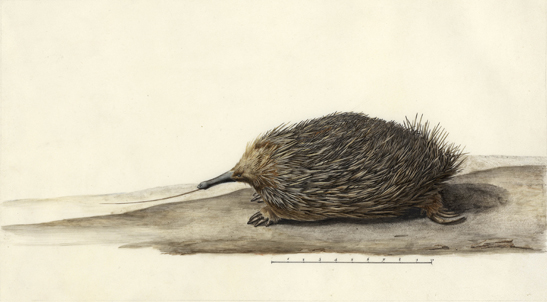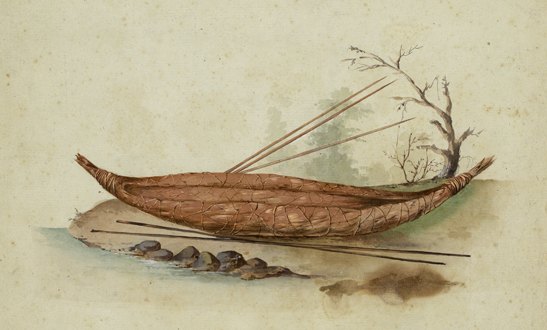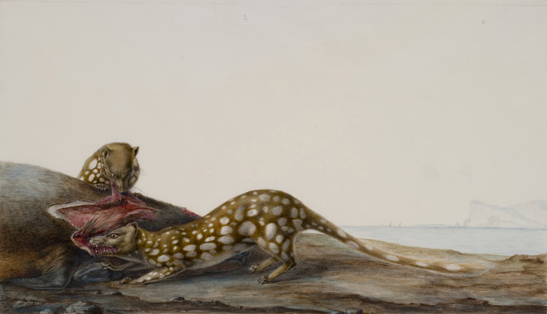The Art of Science: Baudin’s Voyagers 1800-1804

The Tasmanian Museum and Art Gallery (TMAG) is delighted to present an exhibition of exquisite illustrations made by French artists during Nicolas Baudin’s exploration of Australia in the early nineteenth century.
The Art of Science: Baudin’s Voyagers 1800-1804 showcases stunning original watercolours and drawings made by expedition artists Charles-Alexandre Lesueur and Nicolas-Martin Petit during Baudin’s voyage.
The exhibition is currently on a national tour, which has involved a collaboration between the Museum of Natural History in Le Havre, France, and six Australian museums, and many of the artworks on show are coming to Australia for the first time since they were created.
Baudin’s ships, Géographe and Naturaliste, embarked from Le Havre in October 1800 for an expedition to the southern continent, carrying an impressive contingent of scientists and scientific assistants.
Lavishly funded by Napoleon Bonaparte, the expedition’s agenda was the discovery and study of natural sciences, underpinned by the emergence of new ideas and philosophies of reason.
In early 1802, the French explorers landed in Tasmania and spent time interacting with the Tasmanian Aboriginal people and recording their language and culture, flora and fauna as well as collecting cultural objects and specimens.
Lesueur and Petit created their paintings and drawings on the shores and off the coasts of Australia and captured some of the first European views of Australian animals, landscapes and some of the first portraits of Aboriginal people.
TMAG curators were able to gain a special preview of the drawings first-hand when they visited Le Havre in October 2013, as part of their trip to France for the opening of the joint TMAG-MONA exhibition Theatre of the World in Paris
Illustrations featured in the exhibition include evocative portraits of Tasmanian Aboriginal people, images of their baskets and watercraft, watercolours of marine invertebrates, highly accurate profiles of the coastline, as well as drawings of Tasmanian animals such as the now extinct King Island emu.
At TMAG, these original works will be showcased alongside Aboriginal cultural material and zoological specimens from the museum’s collection, which will offer local audiences the unique opportunity to interpret the French expedition from a Tasmanian perspective.

TMAG Director Janet Carding said that the works provide an opportunity to tell many of the stories associated with the interactions between the French explorers and the Tasmanian Aboriginal people.
“Baudin’s expedition represents a significant part of Tasmania’s history and these illustrations provide unique insights into the lives of Tasmanian Aboriginal people pre-colonisation,” Ms Carding said.
The Art of Science also showcases other rare material from French collections such as the engraved copper plate used to print the first complete map of Australia in 1811, Baudin’s chronometer from the Géographe and coastal profiles and hand-drawn maps.
TMAG will be running a series of public talks in conjunction with the exhibition, and young visitors also have the chance to explore the artworks with a special children’s trail – marked by the bubbles of a fish on the wall – which weaves through the gallery.
The exhibition is also accompanied by a detailed and richly illustrated catalogue, which features essays by TMAG curators and is available from the Museum Shop.
The Art of Science: Baudin’s Voyagers 1800-1804 is on show at the Tasmanian Museum and Art Gallery from Friday, 7 April until Sunday, 9 July 2017. The exhibition will be open Tuesday – Sunday, 10:00 am – 4:00 pm.

Image details:
Top: Charles-Alexandre Lesueur (1778 - 1846), Echidna (Tachyglossus aculeatus setosus), watercolour on vellum. Collection: Museum d'histoire naturelle, Le Havre.
Middle: Charles-Alexandre Lesueur (1778 - 1846) or Nicolas-Martin Petit (1777 - 1804), Study of a ninga (bark canoe) with spears, watercolour, gouache and pencil on paper. Collection: Museum d’histoire naturelle, Le Havre.
Bottom: Charles-Alexandre Lesueur (1778 - 1846), Spotted tail quolls (Dasyurus maculatus), watercolour, pen, black ink and pencil on vellum. Collection: Museum d'histoire naturelle, Le Havre.

